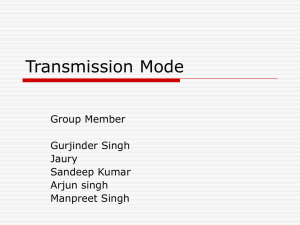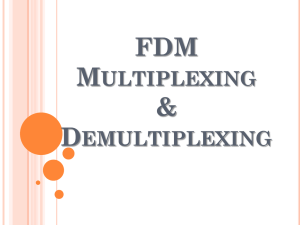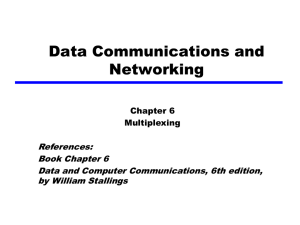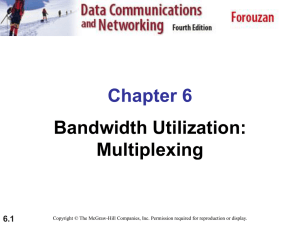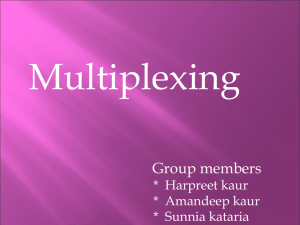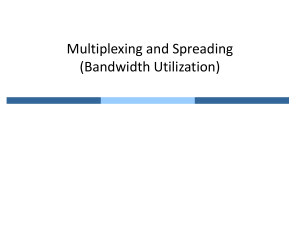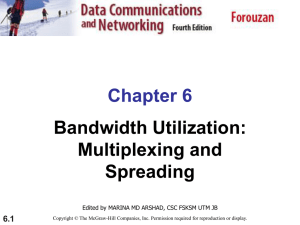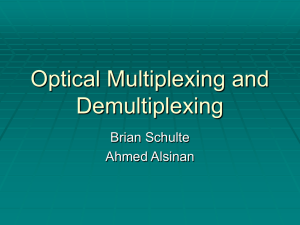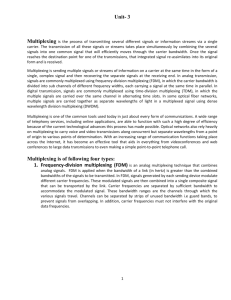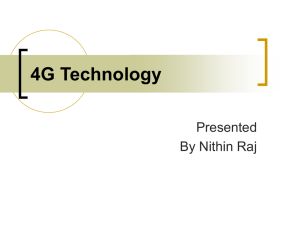EC312 Lesson 18
advertisement
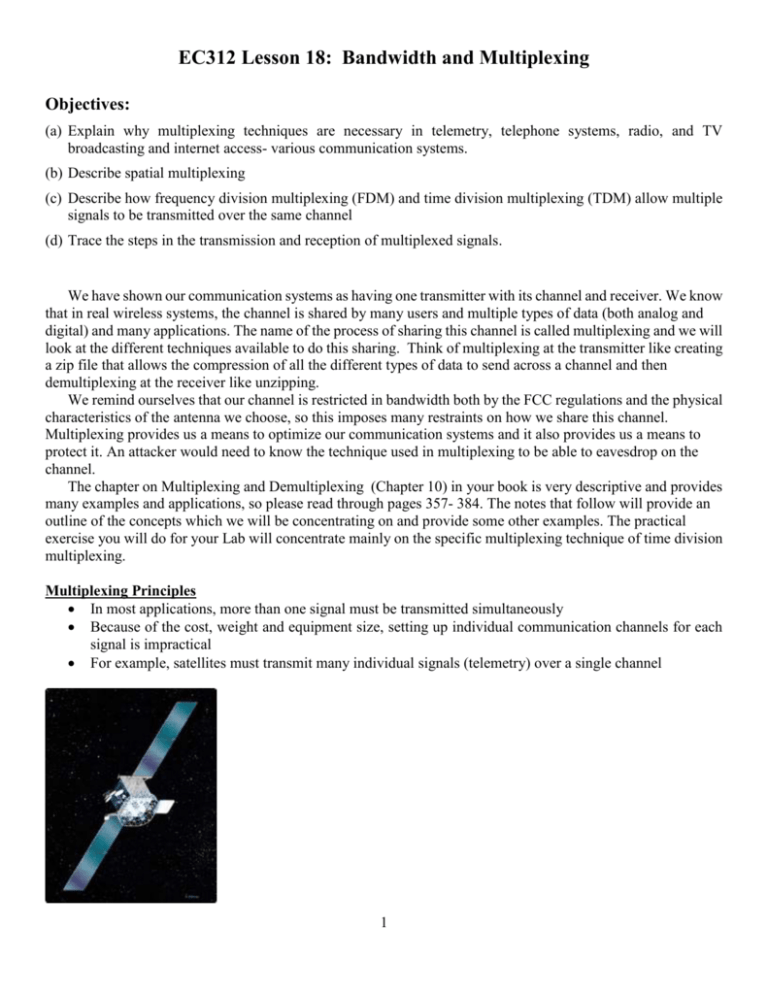
EC312 Lesson 18: Bandwidth and Multiplexing Objectives: (a) Explain why multiplexing techniques are necessary in telemetry, telephone systems, radio, and TV broadcasting and internet access- various communication systems. (b) Describe spatial multiplexing (c) Describe how frequency division multiplexing (FDM) and time division multiplexing (TDM) allow multiple signals to be transmitted over the same channel (d) Trace the steps in the transmission and reception of multiplexed signals. We have shown our communication systems as having one transmitter with its channel and receiver. We know that in real wireless systems, the channel is shared by many users and multiple types of data (both analog and digital) and many applications. The name of the process of sharing this channel is called multiplexing and we will look at the different techniques available to do this sharing. Think of multiplexing at the transmitter like creating a zip file that allows the compression of all the different types of data to send across a channel and then demultiplexing at the receiver like unzipping. We remind ourselves that our channel is restricted in bandwidth both by the FCC regulations and the physical characteristics of the antenna we choose, so this imposes many restraints on how we share this channel. Multiplexing provides us a means to optimize our communication systems and it also provides us a means to protect it. An attacker would need to know the technique used in multiplexing to be able to eavesdrop on the channel. The chapter on Multiplexing and Demultiplexing (Chapter 10) in your book is very descriptive and provides many examples and applications, so please read through pages 357- 384. The notes that follow will provide an outline of the concepts which we will be concentrating on and provide some other examples. The practical exercise you will do for your Lab will concentrate mainly on the specific multiplexing technique of time division multiplexing. Multiplexing Principles In most applications, more than one signal must be transmitted simultaneously Because of the cost, weight and equipment size, setting up individual communication channels for each signal is impractical For example, satellites must transmit many individual signals (telemetry) over a single channel 1 Multiplexer/Demultiplexer Multiplexers combine multiple input signals into a single, composite signal that is transmitted over the medium Telephone systems multiplex millions of calls over fiber optic lines, satellites and wireless paths Common Multiplexing Techniques Three techniques will be discussed o Spatial Multiplexing (Frequency reuse) o Frequency-Division Multiplexing (FDM) Usually used for analog information o Time-Division Multiplexing (TDM) Can be used for analog and digital signals o Code-Division Multiplexing- (CDMA) will be discussed in later lesson Usually used for digital information Spatial Multiplexing Also know as Frequency Reuse Spatial multiplexing transmits multiple wireless signals on a common frequency One method of control is to transmit on very low power so the signals don’t travel very far and interfere with each other Another method is to use carefully controlled antenna radiation patterns to direct the signals in such a way that interference is minimized 2 Frequency Division Multiplexing (FDM) In FDM, multiple signals share the bandwidth of a common communication channel The carrier for each modulator, fc, is on a different frequency The carrier frequencies are equally spaced over a specific frequency range The FDM process divides up the bandwidth of a single channel into smaller equally spaced channels Multiple transmitters now multiplex their frequency data over the channel and then multiple receivers demultiplex by tuning to a specific frequency Transmitting and Receiving an FDM Signal Example: The FM Band is allotted from approximately 88MHz to 108MHz and each transmitter is allowed 200KHz bandwidth for transmission. How many stations will frequency multiplex this specific channel? 3 FDM Applications Telemetry o Used to send feedback from multiple sensors over a single channel Telephone Systems o Had been used for decades to send multiple telephone conversations over a minimum number of cables o The multiplexing process is used at multiple levels to send 10,800 phone calls over a single channel Cable TV o Multiple TV signals are multiplexed on a common coaxial cable FM Stereo Broadcasting o Some FM stations broadcast one or more additional signals referred to as subsidiary communications authorization (SCA) Generally used for broadcasting background music for elevators, stores, offices, etc. o FM stations are also broadcasting an alternative service called radio data system (RDS) Digital data being broadcast includes station call sign, artist name and song title, weather, etc. Example: If a phone system has 10,800 phone calls over a single channel. Using FDM, how much Bandwidth (BW) is necessary? (Assume max voice frequency is 3kHz, and assume amplitude modulation and assume Full-duplex) Time-Division Multiplexing (TDM) In TDM each signal occupies the entire bandwidth of the channel Multiple signals take turns transmitting over a single channel Data is broken up into chunks and assigned to time slots Rotary Switch Multiplexer Early multi-channel multiplexer Commutator switch rotated between multiple inputs Requires transmitter and receiver to be mechanically synchronized to each other Replaced by electronic circuits 4 Electronic Multiplexers Electronic Demultiplexer Demultiplexer is the reverse of multiplexer o It has a single input and multiple outputs Clock pulses in the signal are used to synchronize the receiver 5
